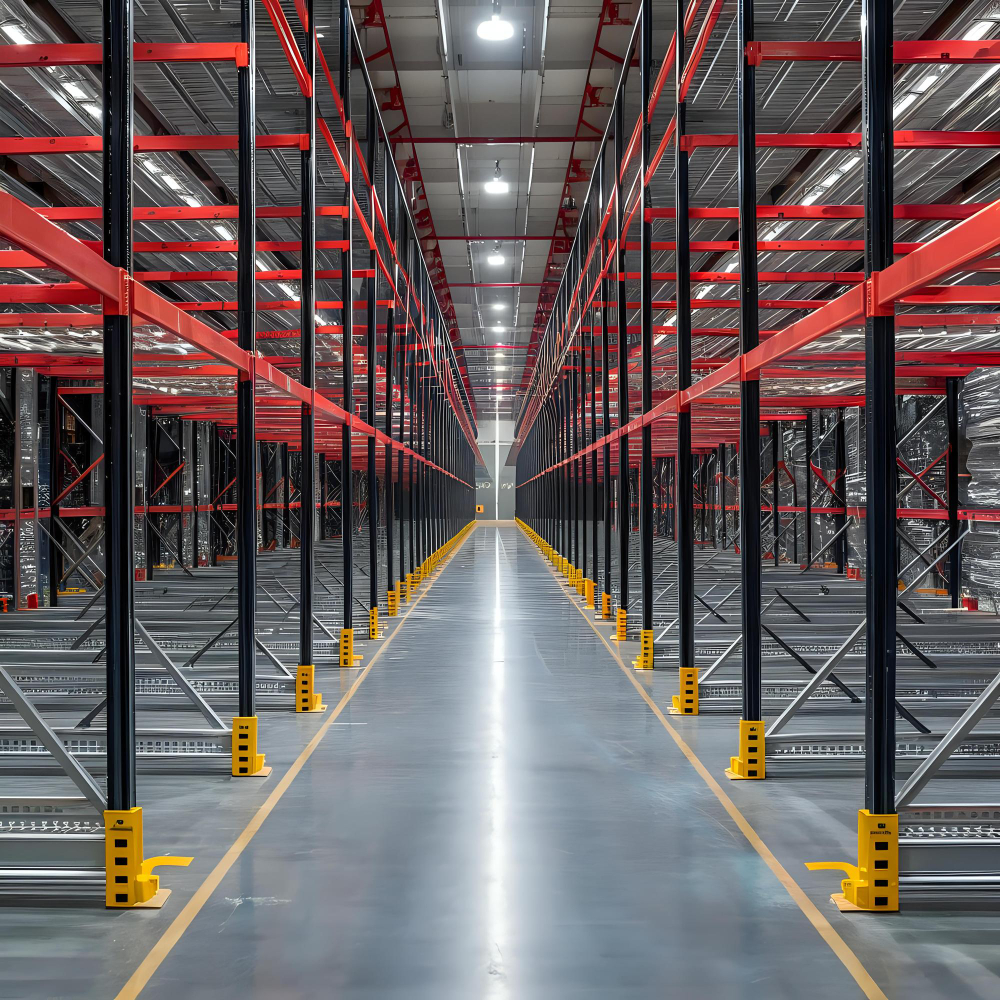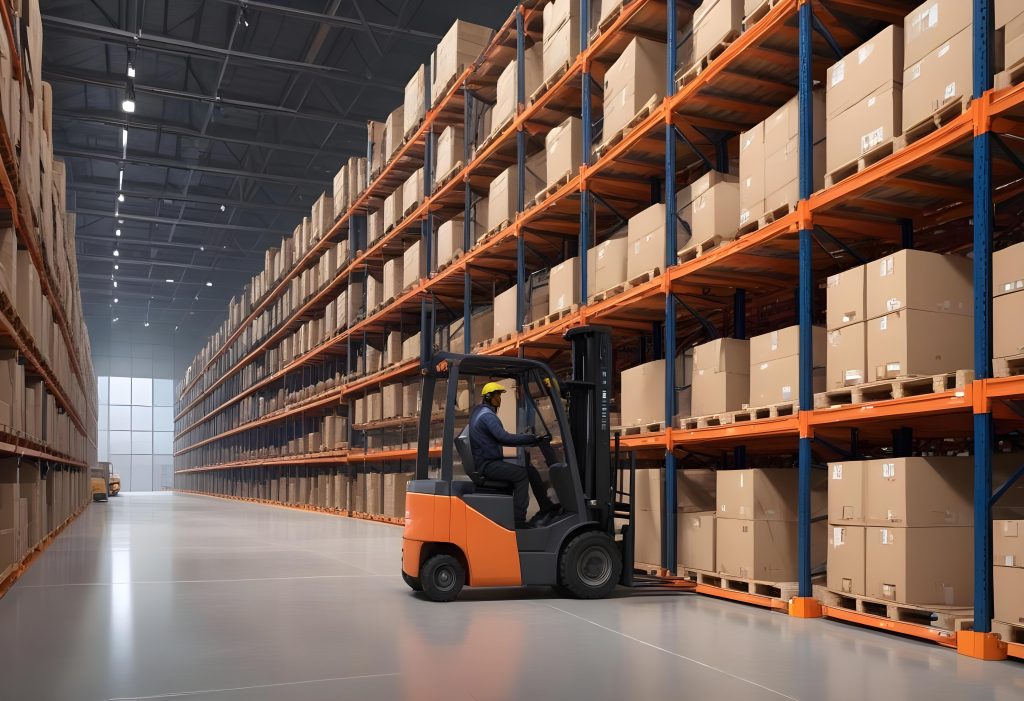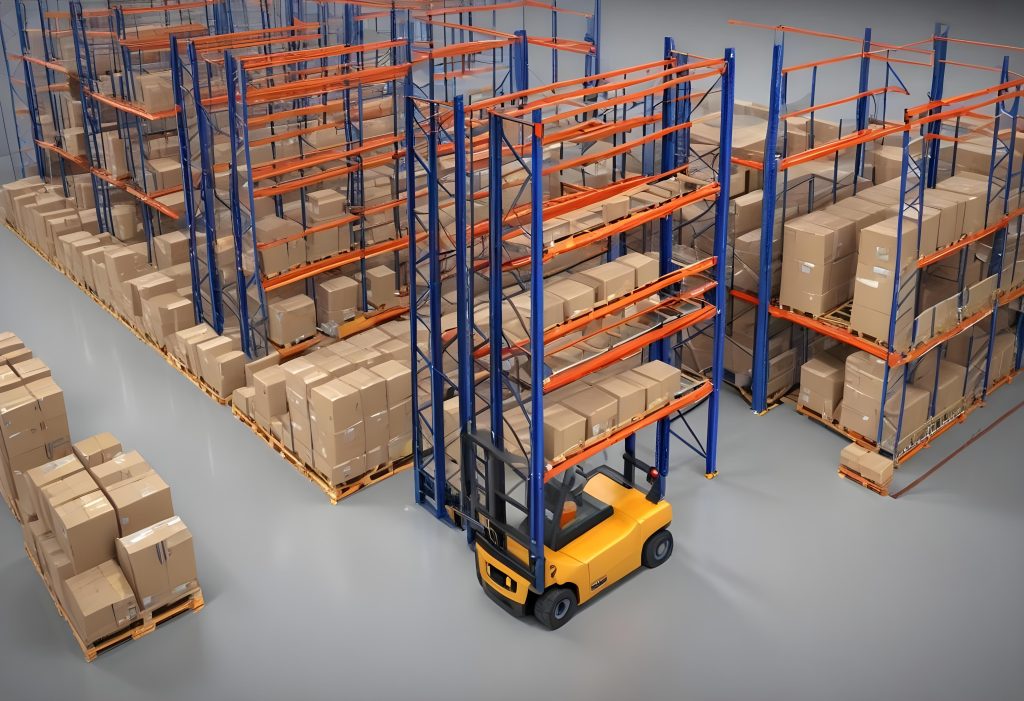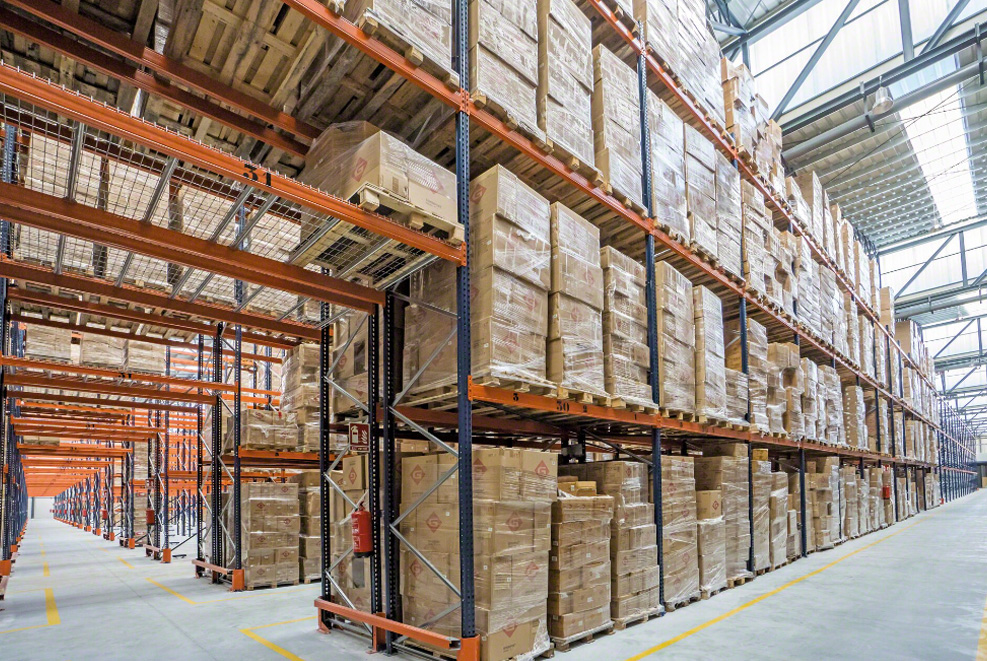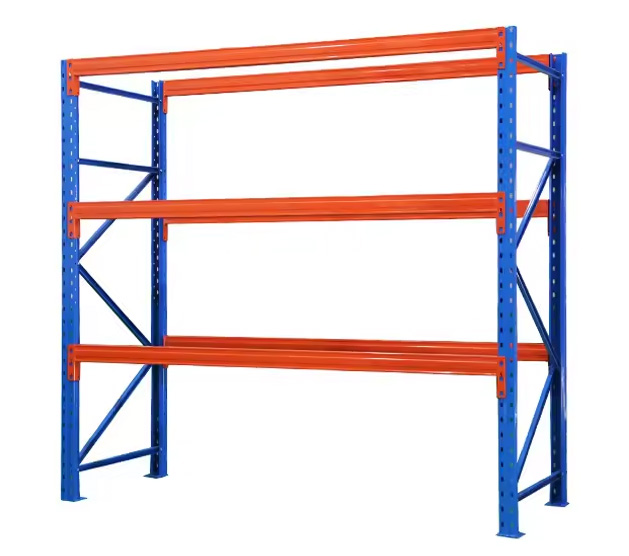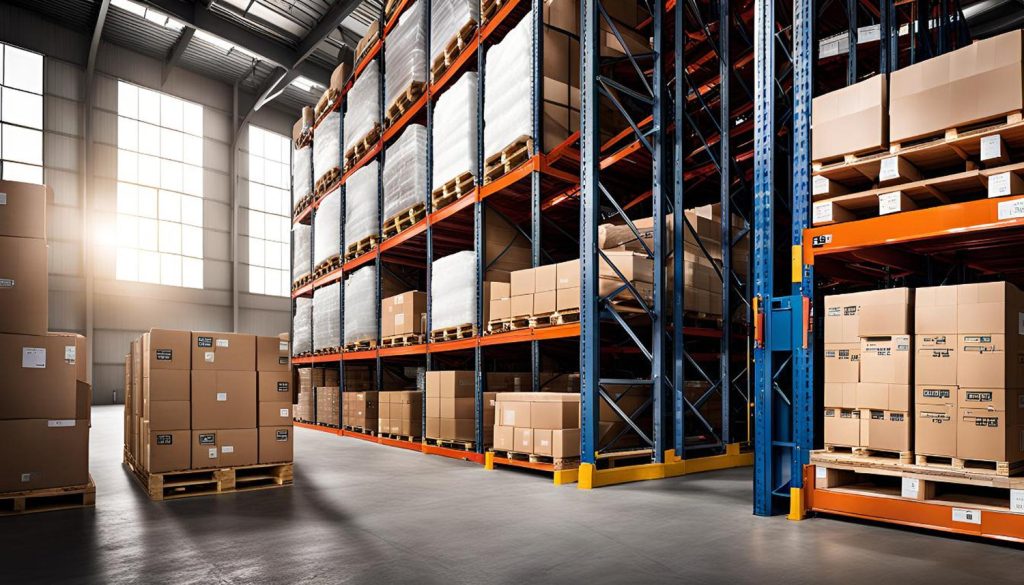Selective racking is the most common storage system in distribution and warehouse businesses designed to facilitate easy access and quick retrieval.
Each pallet is stored in its rack for direct access and easy loading. The height and aisle width can be adjusted according to storage needs. You can keep a wide range of products – from small items to large pallets- using FIFO and LIFO stock management systems.
It consists of vertical uprights and horizontal beams with deck wiring for additional support. Besides, the open design ensures safety and improves visibility for the workers
Selective Racking 101: A Complete Overview of the Different Types
There are two types of selective racking – single-deep selective Racking and double deep Selective Racking.
Single-Deep Selective Racking
Single-deep selective racking is the most common one, where pallets are stored in one deep, allowing easy inventory access without moving others. It makes the inventory management efficient and straightforward. Due to its simple structure, single-deep selective racking is easy to install, maintain, and operate. However, it requires more aisle space, which reduces the storage density.
Double-deep Selective Racking
Double-deep selective pallet racking is an extension of Single-deep selective racking where pallets are stored in two deep, allowing for better access to every pallet. An additional row of pallets is stored behind the front row for higher storage density. This type of pallet rack offers higher storage capacity while providing quick access and retrieval – a perfect balance between space and accessibility.
Advantages of selective Pallet racking System
There are several benefits of using selective pallet racking–
100% SKU accessibility
Selective racking provides unparalleled SKU accessibility. You can directly access any item, reducing the time spent searching and retrieving the item. It also reduces product damage and unnecessary handling.
Wide Variety of Stock Options
Selective racks are designed to accommodate a wide variety of stock options. They support different pallet sizes, weights, and shapes, making them highly versatile for large, heavy items or smaller, lightweight goods with direct access to each pallet.
Efficient SKU management
Efficient SKU management is another major advantage of selective racking. You can access each SKU directly, ensuring accurate stock management and minimizing errors when picking and fulfilling orders.
Cost-Effective Solution
Selective racking requires a low initial investment for installation. Besides, the pallet or forklift handling costs are lower because standard forklifts are inexpensive compared to other specialized equipment.
Adjustable
Selective rackings are adjustable to inventory size, shape, or weight changes. This adjustable pallet racking system suits businesses with growth or fluctuations without significant costs or downtime.
Fast load and unload
Due to easy access and fast retrieval, loading and unloading are easier. It eliminates time-consuming processes, reduces labour costs, and improves productivity without the need for excessive handling equipment.
It can be combined with other storage system
Selective racking offers a hybrid solution that you can use with any kind of racking. It maximizes warehouse efficiency and space utilization. You can utilize the warehouse space to handle fluctuations in product volume or seasonal changes.
No special truck requirements
Other rackins, such as drive-in racking, need specialized forklifts with extended reach capabilities. Selective racks do not require any special lift trucks to operate. It facilitates warehouse operation and reduces the overall cost. Additionally, using standard tools improves flexibility and efficiency.
Floor level is not a critical factor.
The selective racking system is adaptable to various warehouse environments, regardless of uneven flooring. Unlike other racking systems that need perfectly levelled floors to ensure stability and safety, selective racking can be installed on slightly uneven floors without compromising quality and safety.
Disadvantages of Wearhouse selective Pallet racking
Low storage space
One of the main disadvantages of selective pallet racks is limited storage capacity. Each pallet is placed independently for direct access, reducing overall storage. This is a problem for people looking to maximize space utilization or businesses with storage requirements.
Require large warehouse space.
Selective pallet racking systems require wide aisles for forklift access and individual pallet retrieval. It can be a problem for a business with small warehouse space. Businesses in areas with high real estate prices can face problems scaling their business with selective racking that limits access to every pallet.
Limited height
The maximum height for a selective pallet rack is 12 meters. This limitation restricts the vertical space capabilities of a warehouse. Besides, the height limitation may increase extensive warehouse footprints to accommodate the same amount of inventory.
Not suitable for large storage
Selective rackings focus more on accessibility rather than storage density. The design emphasizes quick retrieval and easy load-unload, resulting in more aisle space and lower storage density. Selective racking systems fail to accommodate Industries with high inventory levels and large quantities.
Which Racking System is Right for You? An In-Depth Comparison –
|
Feature |
Selective Racking | Drive-In Racking | Push-Back Racking | Pallet Flow Racking |
Cantilever Racking |
| Storage Density | Low | High | Medium | High | Medium |
| Accessibility | 100% direct access | Limited access (LIFO) | Limited access (LIFO) | FIFO access | Direct access to long items |
| Cost | Moderate | Low initial cost | Higher initial investment | High due to complex systems | Varies based on customization |
| Ideal For | High SKU variety, fast-moving items | Bulk storage of uniform products | Moderate turnover, varying SKUs | High turnover, uniform items | Long, bulky items such as lumber or pipes |
| Space Utilization | Requires more aisle space | Maximizes space by reducing aisles | Better space utilization than selective racking | Excellent space utilization, fewer aisles | Optimized for awkward items, varies by length |
5 Key Factors to Choosing the Perfect Racking System for Your Space
Space
Space is the most important factor to consider while choosing the right racking. Analyze your warehouse’s total square footage and ceiling height, measure the width of aisles, and consider the columns, doors, and other obstructions to understand the right racking system.
Storage needs
Your storage needs will determine the racking type. Check your inventory or product type, determine the volume and density, calculate the turnover rate, and consider the pallet load capacity. These will help you identify the right rack.
Stock management needs
Know the type of stock management you need – for example, First-In-First-Out (FIFO) or Last-In-First-Out (LIFO) system. Track your inventory and order picking, understand the SKU variety, and consider the zoning requirements for different product categories to pick the perfect solution.
Truck availability
What type of truck do you have? Does that suit the rackings you are planning to install? If not, think twice. For example, a narrow aisle requires a specialized forklift where selective rackings can work with any truck.
Cost
Finally, consider the cost and return. Calculate the initial investment, installation, and maintenance costs and compare them to other racking systems. It will give you a clear idea of your investment in racking.
What is Selective Racking?- FAQs
How are selective rackings different from others?
Selective rackings differ in direct accessibility, easy loading and unloading, and cost-effectiveness.
What are some common maintenance requirements for selective racking?
Selective rackings require replacing damaged components only. Apart from that, regular cleaning and avoiding heavy loads is mandatory.
What types of products are best suited for selective racking?
Selective racking is suitable for businesses with high turnover rates, diverse SKUs, and varying sizes such as such as retail, e-commerce, and distribution centers
How easy is it to install and maintain selective racking?
It is the easiest of all rackings to install and maintain selective racking. The cost of installing selective racking is relatively lower than that of other systems.
Wrapping up
Selective racking is commonly used in warehouses for its direct accessibility, quick retrieval, scalability, cost-effectiveness, and simple installation. You can use it to improve the efficiency of your warehouse and inventory management.
However, remember that it is not suitable for higher storage needs. Make sure you have enough space to install the selective rackings since they need a wide aisle to install.
Consider all the important factors such as storage needs, cost, maintenance, ease of use, and others to pick the best racking for your business.
Contact Matco Distributor and get ideas about which pallet racking fits you and how our pallet racking system can help you to solve your warehouse storage solution.
Office/Warehousing Address– 3265 Gateway Rd, Suite 350, Brookfield, WI
Phone- (414) 445-4066
E-Mail- info@matcodist.com

